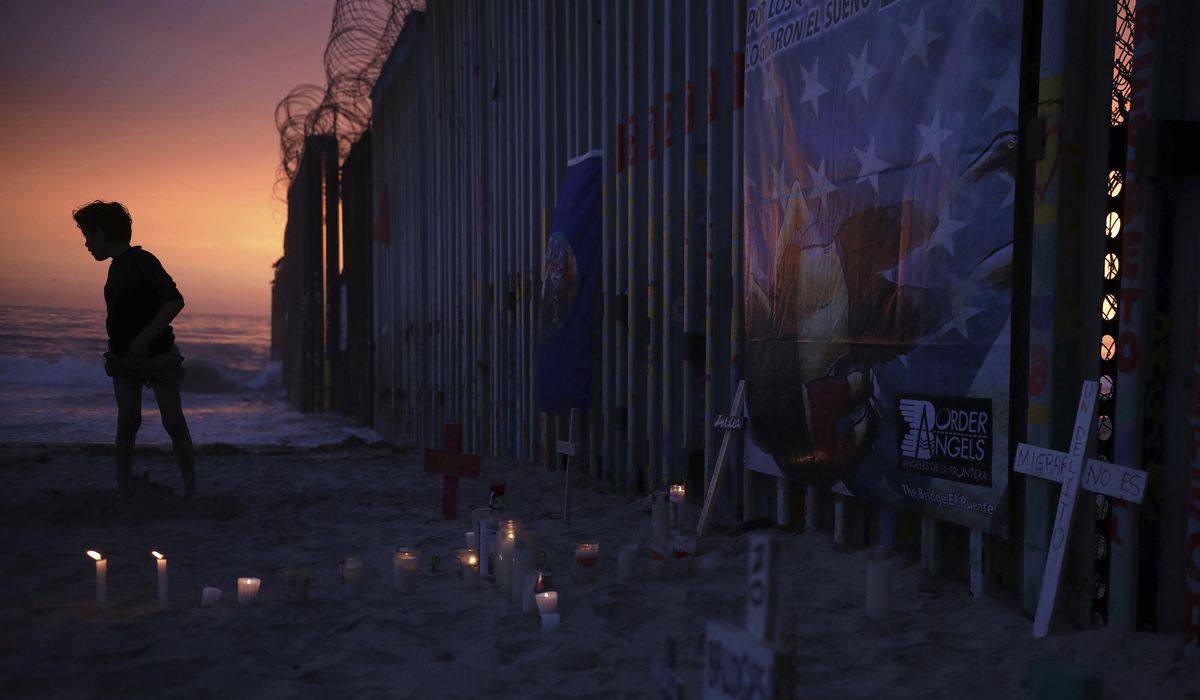
The Border Patrol counted 557 migrant deaths along the southern border over the past year, shattering the previous record and putting a body count on the ongoing illegal immigrant surge.
The situation could have been worse but for heroic efforts by agents, who set a record for rescues, with 12,854. That was more than twice the number recorded in fiscal 2020, which had been the record-holder.
Experts say it’s a matter of numbers.
Border Patrol agents caught more people attempting the crossing in fiscal 2021 than in any previous fiscal year. More people trying means more risky attempts and more people dying.
“The simple fact is when you’re dealing with as many people as we’re currently dealing with, you’re going to have more deaths, you’re going to have more rescues,” said Brandon Judd, president of the National Border Patrol Council.
The 557 deaths easily topped the record year of 2005, when agents counted 492 deaths. In fiscal 2020, just 247 deaths were tallied, and in 2019, during the previous migrant surge, 300 deaths were recorded.
The deaths span the U.S.-Mexico boundary and include everything from exposure to the elements to falling off the border wall, which has grown in frequency as the barrier was extended and built higher over the past four years.
Catastrophic vehicle crashes also have soared as smugglers increasingly try to make a break for it, leading authorities on high-speed chases. Drownings in the Rio Grande also have risen, particularly in areas such as Del Rio, which used to be among the quieter parts of the border but has become a focal point for the current migrant surge.
Del Rio and the Big Bend and El Paso sectors, which cover western Texas and New Mexico, each set records for deaths in fiscal 2021, which ended Sept. 30.
The deaths are tragedies for families, and Mr. Judd said they take a toll on agents, too.
Answers are tougher to come by.
“The only way it stops is if you put policies in place that don’t incentivize illegal immigration,” Mr. Judd said.
Fiscal 2022, which began Oct. 1, has picked up right where the previous year left off.
Over the weekend, the Border Patrol announced the death of a woman who drowned while trying to swim around the border barrier that stretches into the Pacific Ocean in San Diego.
Agents received a tip that as many as 70 people were making a mass attempt to swim around the barrier just before midnight Friday. They nabbed 36 adults and pulled the unresponsive woman from the water.
“This is yet another example of the ruthless tactics smuggling organizations use to bolster their power and profits,” Aaron Heitke, chief patrol agent in the San Diego area, said in a statement.
He said the agency will try to catch those responsible for the mass swim.
Around 5 a.m. Thursday, a migrant died after running off a steep cliff in Eagle Pass, Texas.
Agents said they spotted three people walking through a field and responded. When they turned on their flashlights, the migrants ran toward brush that concealed the cliff. Two migrants went over the edge. One was dead at the scene and the other was critically injured, agents said.
Smugglers responsible for migrant deaths can pay dearly.
Prosecutors last month won a 30-year prison sentence against Jorge Luis Monsivais, who was ferrying 13 illegal immigrants through Dimmit County, Texas, in 2018.
As Monsivais, 23, fled from agents and local sheriff’s deputies, he crashed the Chevrolet Suburban he was driving, ejecting some of the migrants. Four were dead at the scene, a fifth died en route to the hospital, and others were left with broken necks, hips and head trauma.
U.S. Attorney Ashley C. Hoff called the case “heartbreaking” and said the severe sentence should send a message to would-be smugglers.
But plenty of people are still lining up for the chance to smuggle and make big money. The Washington Times database of smuggling cases shows a typical going rate of $1,000 per illegal immigrant smuggled from the border deeper into the U.S.
Short of solving the border surge, there is probably not much the government can do to solve drowning deaths. Short of changing policies to prevent vehicle pursuits, there’s little that can be done to curtail traffic deaths.
But the Department of Homeland Security has invested in rescue beacons and surged its own medical response teams to try to cut the number of deaths from exposure or severe illnesses in those coming across the border.
In the Rio Grande Valley, the deadliest Border Patrol sector along the U.S.-Mexico boundary, Homeland Security was working this fall to double the number of rescue beacons to 48. The El Paso sector, where deaths jumped from 10 in 2020 to 38 in 2021, is looking to add 15 beacons this year, bringing its total to 20.
Not all rescues are illegal immigrants.
Finding lost hikers in southwestern deserts or remote forests of the northwest are regular occurrences.
In one case in September, agents dove into the Pacific Ocean to rescue a Mexican man who had been swimming on the Mexican side of Friendship Park, the binational beach that spans the border in San Diego and Tijuana. A rip current pulled the man past the border barrier and toward the U.S. side. It left him fatigued and struggling to stay above the surface.
Agents called lifeguards but became worried that the man wouldn’t survive until their response, so they swam through the dangerous currents to bring him in. He was given first aid and returned to Mexico.
Mr. Judd said water rescues are the most concerning for agents. Vehicle pursuits can be dangerous, but agents can train for that.
Jumping into swirling waters, though, leaves agents at the mercy of the elements.
“That’s probably the most dangerous situation,” Mr. Judd said.








